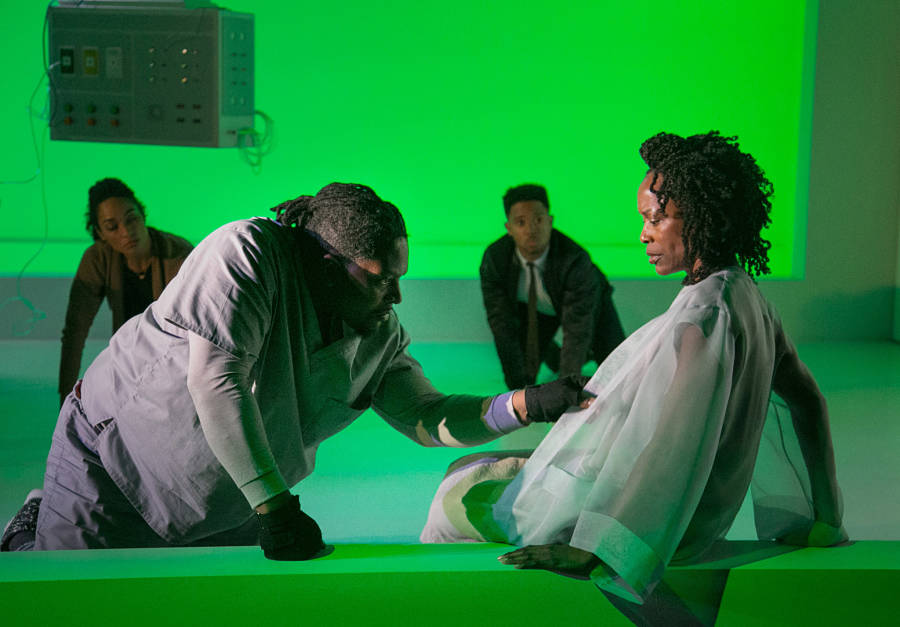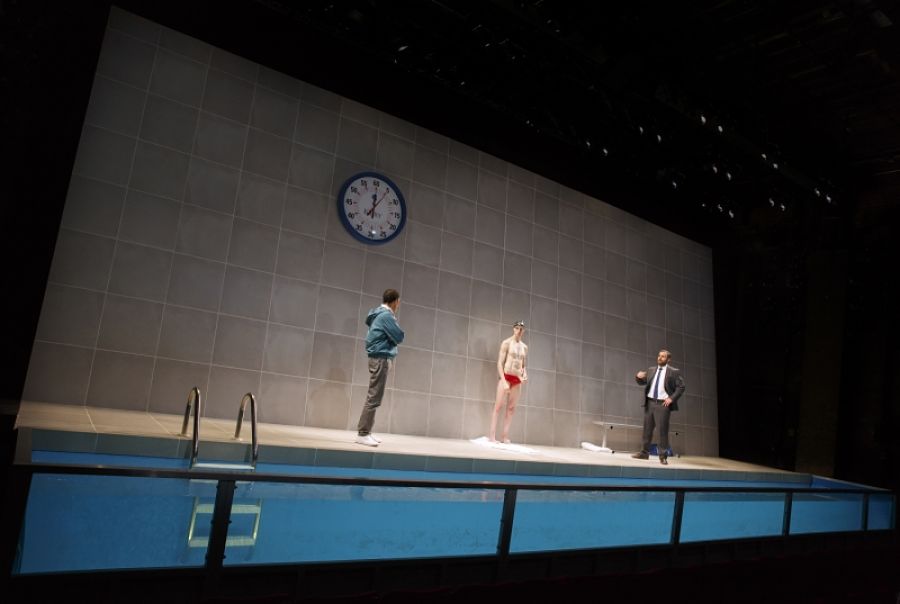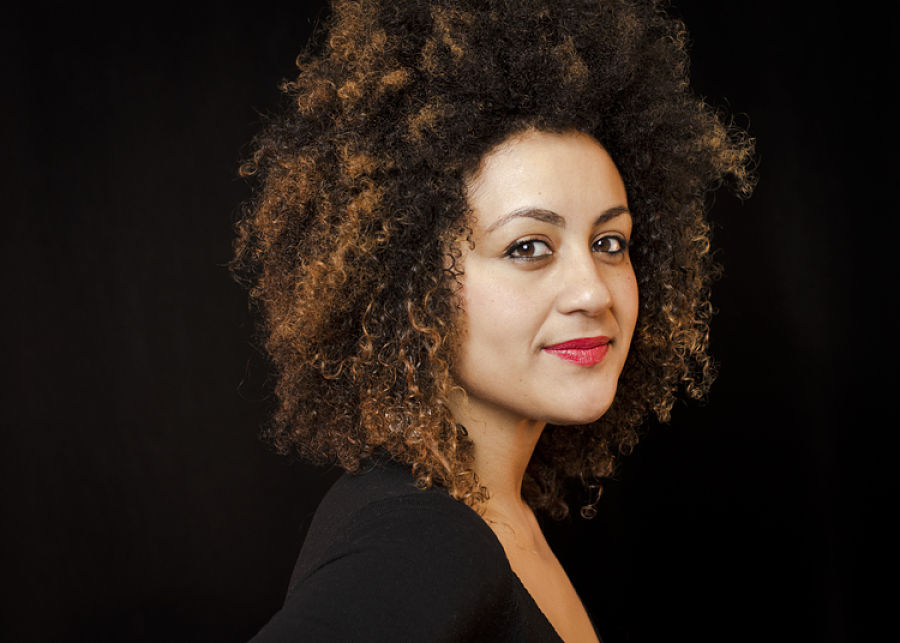Lucas Hnath had never met Lileana Blain-Cruz when New York Theatre Workshop suggested that she might be a good choice to direct his play Red Speedo. So the playwright called around to some friends who knew Blain-Cruz and her work. They told him she was unusually perceptive, collaborative, and so passionate about the creative process that she sometimes danced during rehearsals. Hnath signed on.
He isn’t the only playwright of note who has grabbed a spot on Blain-Cruz’s dance card. In just the past six months, the 31-year-old director has staged Hnath’s morality tale on doping and the cost of winning in the world of competitive swimming; British playwright Alice Birch’s jagged neofeminist manifesto Revolt. She Said. Revolt Again. for Soho Rep, and War, the family drama she and her longtime friend Branden Jacobs-Jenkins premiered at Yale Repertory Theatre two years ago and is currently in previews at LCT3, Lincoln Center Theater’s showcase for emerging playwrights and directors (it opens June 6 and runs through July 3).
And that’s not all. In the fall, Blain-Cruz will kick off Pulitzer winner Suzan-Lori Parks’ residency at Signature Theatre with a revival of The Death of the Last Black Man in the Entire World.

These plays are as different from one another in style and substance as a Shakespearean comedy is from a Greek tragedy—significant productions of which Blain-Cruz has also done—and that’s just the way she likes it. “I love that nobody can be like, ‘Lileana does this kind of play.’ No. I do all of them,” she says. “And that’s the fun.”
Raised in Miami and New York by a Haitian mom and a Puerto Rican dad, Blain-Cruz first caught the stage bug when her parents took her and her brother to see La Traviata at the Metropolitan Opera when she was 10. She was bowled over by the theatricality of the entire experience. “It felt like a huge adventure,” she recalls. “The chandeliers were going up and then the curtain was going up and I was hooked at that moment. I was like, ‘What is this? This is amazing.'”
A sense of wonder and appreciation for a heightened theatrical experience has become a trademark of Blain-Cruz’s own work. As a directing fellow at NYTW during the 2013-2014 season, she staged a workshop production in which she explored the possibilities of adapting the Romanian writer Tristan Tzara’s 1921 experimental play The Gas Heart and the Chilean filmmaker Alejandro’s Jodorowsky’s absurdist Western El Topo.
“Those presentations were unique, they were alive and really physical and visceral and theatrical,” says Aaron Malkin, the literary associate at NYTW who facilitated the meeting between Hnath and Blain-Cruz. “It showed her wide range of interests and the expansive way she thinks about theatre as an art form.”
This audacious approach to theatremaking is also reflected in Blain-Cruz’s admiration for two major European directors known for prizing the visual aspects of theatre as much as, if not more than, the narrative.
“I’ve always been drawn to the visual world of Romeo Castellucci,” Blain-Cruz says of the Italian auteur. “He in some ways feels like an installation artist on the stage. And then there’s the kind of dynamic ensemble inside a very specific visual world that Ivo van Hove creates.”
She also cites her Yale Drama School professor Liz Diamond as another major influence who taught her that in “even the craziest of texts, there’s always a story.” The result is a guiding aesthetic that allows Blain-Cruz to “enjoy mining what an environment can bring to a story—you know, the kind of totalistic theatre.”
Playwrights who work with Blain-Cruz praise this holistic approach, in which she works closely with them and designers to transform their text into daringly visual and visceral performances. “I need someone who I can trust to make something beautiful happen,” says Jacobs-Jenkins, who has known her since they acted in plays together at Princeton.
The visual concept for Hnath’s Red Speedo drew gasps of appreciation from audiences. It was set in a photorealistic swimming club, complete with antiseptically clean tiled walls and a stage-length lap pool with a transparent front—visual rebukes to the lying and cheating that, to varying degrees, all the characters employ for their personal gain.

The beauty isn’t always literal. The set for Revolt. She Said. Revolt Again. was nearly anorexic, with brief scenes playing out in metal folding chairs set against the backdrop of a few plants and a big screen on which projections announced the title of each vignette. The final scene, the worst family dinner ever, was staged around a table that, along with the plants, got swept up in a whirlwind of fury that, accompanied by unnerving lighting effects and deliberately abrasive sounds, created a perfect metaphor for the rage the play dissects.
The approach doesn’t always draw fans. Blain-Cruz’s modern-dress production of Shakespeare’s Much Ado About Nothing for Oregon Shakespeare Festival last summer earned some harrumphs for underscoring a comparison between the play’s returning soldiers and vets coming back from Iraq and Afghanistan, and for casting an actress who uses a wheelchair as the disgruntled outsider Don John. “Sure, the world then as now was filled with war and inequalities based on sex, race, and class,” griped one local reviewer. “It’s still best to let Shakespeare be relevant on his own, like it or not.”
But it’s just a willingness to shake up a text, old or new, that Blain-Cruz’s collaborators appreciate. During their first meeting, Hnath says he asked her what she thought would be the most difficult part of directing his play.
“She kind of cut straight to some very specific thoughts about acting style, and I can’t remember exactly the word she used, but what we were talking about a lot was the very narrow emotional bandwidth that you have to operate in when you’re doing my plays,” he says. “It was a very technical answer and it was exactly the right answer—the answer I’m always looking for when I talk to a director about my plays. And I was just really taken aback by how just quickly she nailed it.”
Later, during previews, as Hnath and Blain-Cruz struggled with a climactic fight toward the play’s end, she got onstage and acted it out with him so that they could literally feel its authenticity.
Jacobs-Jenkins also values the conversational and collaborative way Blain-Cruz works. “She leads this sort of journey toward like a group discovery of the central thesis or experience of the play,” he says. “If you look at me, Lucas, and Alice Birch, we’re kind of all in the same ZIP code artistically. We’re all making pretty conceptual work with political undertones or underlace to it. So I guess we’re all collectively attracted to her because there aren’t a ton of directors out there who are taking that work on. She’s one of the people who’s doing it.”
Blain-Cruz’s feeling about working with these playwrights is mutual. “The thing that’s most exciting about new work is that it feels like it’s in conversation with the right now,” she says. “What I like about these new playwrights is that they’re asking really big questions and doing it in interesting formal ways, and that’s really exciting for me.”
Ditto for the audiences who get to see what she does with that work.


